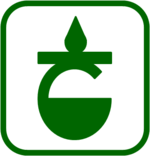Arabian Gulf Oil Company
 | |
| State-owned | |
| Industry | Petroleum |
| Founded | 1979 |
| Headquarters | Benghazi, Libya |
Key people | Mohamed Ben Shatwan (Chairman) |
| Products |
Exploration Oil and gas |
| Website | Official website |
The Arabian Gulf Oil Company (Agoco; Arabic: شركة الخليج العربي للنفط) is an oil company based in Benghazi, Libya, engaged in crude oil and natural gas exploration, production and refining. It was a subsidiary of the state-owned National Oil Corporation (NOC).[1][2]
Overview
Agoco's roots go back to 1971 when the Arabian Gulf Exploration Company (AGECO) was established, following the implementation of Law No. 115, issued by the Libyan Revolutionary Command Council nationalizing shares held by British Petroleum (BP). Agoco was formed by the NOC in late 1979 to take over the assets of a partnership of BP and Nelson Bunker Hunt of the United States, and a partnership of Chevron and Texaco called Amoseas. Agoco has upstream operations in eight oil fields, including Sarir, Messla, Nafoora, Beda and Hammada. The company also operates an oil terminal and a refinery in Tobruk and Sarir.
Agoco Fields
The Sarir field was discovered in the Sirte Basin by BP in 1961 is considered the country's largest field.[3] The Messla field was discovered in 1971 and is situated 500 km southeast of Benghazi and is also considered as one of the biggest fields in the Sirte basin. Nafoora field is situated in the northeastern part of the Sirte basin and discovered in early 1965.[4] The Beda and Hamada fields were discovered during 1959, in the eastern Sirte basin and the southern border of the Grahames basin respectively. Bede and Hamada are nearly considered dead fields unless new Enhanced oil recovery technology can be implemented. Additionally, Agoco often operates fields owned by other companies. Agoco production was estimated by NOC at around 430,000 bbl/d (68,000 m3/d) in 2003. As of 2010, Agoco produced around 400,000 bbl/d (64,000 m3/d), representing approximately 25% of total Libyan crude oil production.
Refineries and Oil Terminal
The Sarir refinery started operations in 1989 and has a refining capacity of 30,000 bbl/d (4,800 m3/d). The fuel supply from the refinery meets requirements for the Sarir Agricultural Project as well as for the general area. Agoco also has a 9,000 bbl/d (1,400 m3/d) portable petroleum refinery or topping plant at Sarir. The Tobruk refinery has been on stream since 1971 and entered the production phase during 1989. In 1990, the refinery operations were transferred to Agoco after being directly managed by the NOC. In 1996, Tobruk had two thermo-compression distillation units installed to produce 750 cm/d of drinking water from the Mediterranean Sea. The General contractor for the project was United Kingdom-based Weir Westgarth Ltd., a subsidiary of the Weir Group. Currently, Tobruk has an estimated capacity of 20,000 bbl/d (3,200 m3/d).
The Marsa El Hariga Terminal (Tobruk) is situated on the southern coast of the Tobruk trading port. Construction of the terminal started in 1964, and was completed in 1966. The Marsa El Hariega oil terminal was officially inaugurated by exporting the first shipment of crude oil from Sarir in 1967. The crude from Sarir is pumped through a 400 km pipeline, with an auxiliary pumping station between Sarir and the terminal. Marsa El Hariga has three berths with a loading capacity of 8,000 tons/hour for tankers of up to 120,000 tonnes deadweight (DWT). Other ancillary facilities at the terminal include oil products storage tanks with a capacity of 116,500 cubic metres.
2011 Libyan civil war
The Arabian Gulf Oil Company has announced plans to use oil funds to support anti-Gaddafi forces.[5]
See also
Notes
- ↑ EIA (2007)
- ↑ "Libya rebels fight to keep oil lifeline open". Financial Times.
- ↑ C. Lewis (1990)
- ↑ T. Ahlbrandt (2001)
- ↑ "Libya's Arabian Gulf Oil Co hopes to fund rebels via crude sales-FT". Reuters. 11 March 2011.
References
- C.J Lewis (1990) Sarir Field: Sirte Basin, Libya
- Energy Information Administration (2007) Libya: Country Analysis Brief
- World Bank (2006), Libyan Arab Jamahiriya: Economic Report, Social & Economic Development Group: MENA Region
- P. Mobbs (2002) Mineral Industry of Libya
- P. Mobbs (2000) Mineral Industry of Libya
- Thomas S. Ahlbrandt (2001) The Sirte Basin Province of Libya: Sirte-Zelten Total Petroleum System U.S. Geological Survey
- BBC News